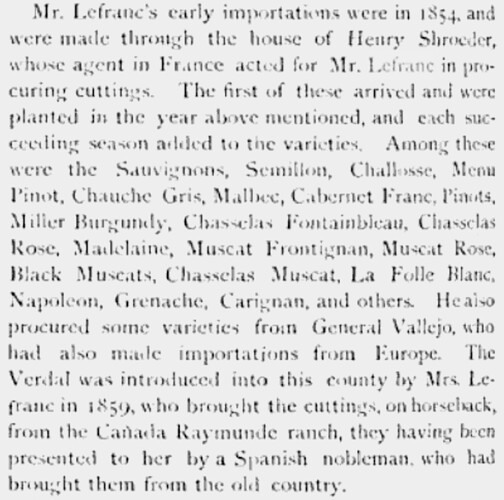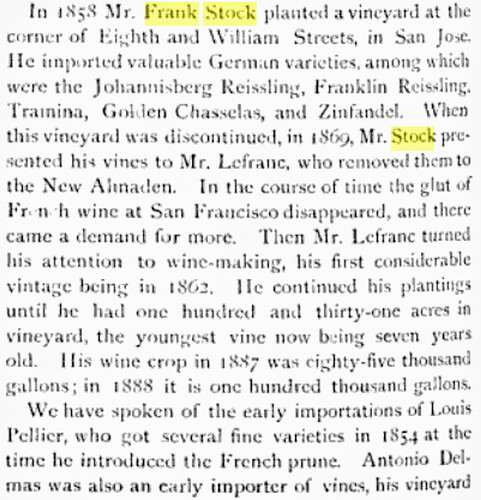I found an interesting book online that provides some details about the early vineyard owners of the Santa Clara / Santa Cruz Mountains region.
Google Books: “Viticulture” in
Pen Pictures from the Garden of the World, Or, Santa Clara County California, 1888
by Horace S. Foote
According to the text, several varieties of winegrapes were introduced to the San Jose-Santa Clara Valley area by Charles LeFranc (imported via Henry Shroeder), Frank Stock, Peter & Louis Pellier, as well as Antoine Delmas.
Charles LeFranc also secured other cultivars from General Vallejo’s vineyards. Mrs. LeFranc purchased different varieties via the Cañada Raymunde Ranch.
Charles LeFranc is alleged to be the first to have grown Grenache in California.
Per one web-based resource, Pinot Noir growing in California came about via “Pierre Pellier, Colonel Agoston Haraszthy de Mokesa, founder of Buena Vista Winery, or Charles LeFranc”.
Francis Stock of San Jose reportedly introduced Riesling to growers on the West Coast, along with Sylvaner and Traminer. Sonoma County’s Emil Dresel also played a pivotal role in spreading a number of white grape cultivars throughout the state.
Foundation Plant Services
Wine Grapes of UC Davis
by Nancy L. Sweet, FPS Historian, University of California, Davis
December, 2018
"Riesling at FPS: “…Stock was probably the first to import Riesling to California to his San Jose nursery prior to 1857. He supplied Riesling cuttings to Dr. George Crane in Napa in 1859; those are believed to be Napa’s earliest Riesling.”
Antoine Delmas appears to have pioneered Zinfandel cultivation in the Santa Clara Valley.
Pierre Pellier is credited with being the first to import Mourvèdre (among other grapes) into California.
A report from 1885 lists many local grapegrowers and wine producers. The second page features an investigation into how certain cultivars were introduced in California.
Internet Archive
The San Francisco Merchant, Vol XIV No 6
“Report of the First District Convention of the San Francisco Viticultural District”
July 3, 1885
The following link tells the history of grape-growing and winemaking around Cupertino.
· City of Cupertino
“Cupertino’s Wine Country”
*** EDIT ***
I am including a book that identifies late-19th Century grape-growers and wine producers (by county and city). Some of the entries list the grape varieties cultivated by individuals, as well.
Google Books
Directory of the Grape Growers: Wine Makers and Distillers of California, and of the Principal Grape Growers and Wine Makers of the Eastern States (1891)
Board of State Viticultural Commissioners
A.J. Johnson, Superintendent
254 pages

